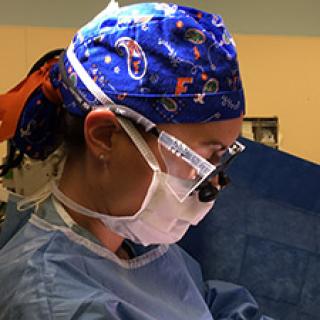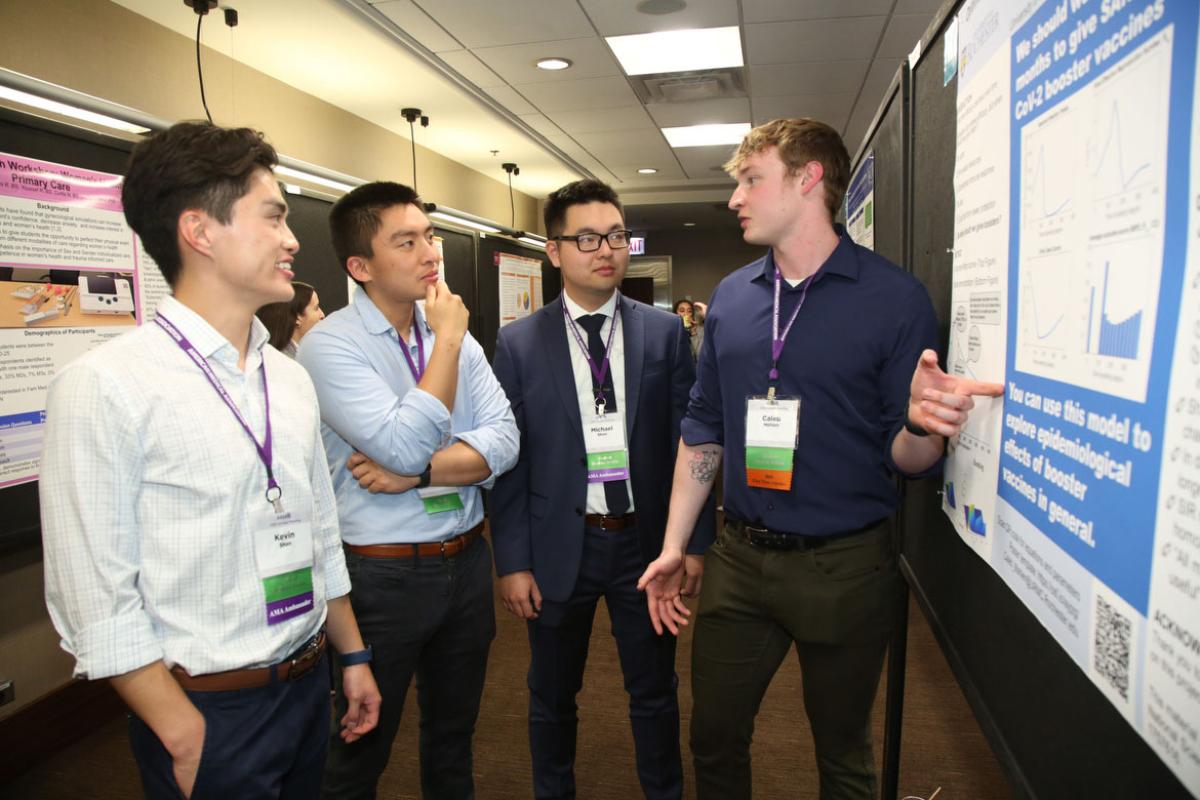As a medical student, do you ever wonder what it’s like to specialize in pediatric neurosurgery? Meet Krystal Tomei, MD, MPH, a pediatric neurosurgeon and a featured physician in the AMA’s “Shadow Me” Specialty Series, which offers advice directly from physicians about life in their specialties. Check out her insights to help determine whether a career in pediatric neurosurgery might be a good fit for you.
The AMA’s Specialty Guide simplifies medical students’ specialty selection process, highlight major specialties, detail training information, and provide access to related association information. It is produced by FREIDA™, the AMA Residency & Fellowship Database®.
Learn more with the AMA about the medical specialty of pediatric neurosurgery.
“Shadowing” Dr. Tomei
Specialty: Pediatric neurosurgery.
Practice setting: Academic hospital.
Employment type: Employed by hospital.
Years in practice: Seven years.
A typical day and week in my practice: My day varies depending on whether I’m doing admin work, in clinic, or in surgery. My surgical days typically run from 6:30 a.m. until somewhere around 5 p.m., but can last longer if I have a long lineup of surgeries. Clinics occur two half-days per week, either morning or afternoon between 8 a.m. and 5 p.m., and sometimes involve an extra half a day of a multidisciplinary clinic.
My admin time is a hodgepodge of paperwork, research, calling patients, and whatever clinical stuff gets thrown in there too. Every day, I will round on my inpatients. And evenings are when I may work through my “extracurricular activities” in organized medicine, prepare and plan for a difficult case, catch up on journal articles, or just enjoy a relaxing night watching some mindless TV.
I generally anticipate that I’m working from about 7 a.m.–5 p.m. on any given day. Occasionally I’m done a bit earlier, frequently I’m stuck a bit later. I’m on call for about one-third of the year and those days can range from incredibly busy to incredibly slow. But the call schedule is very dependent upon how many people are in the practice that you join.
The most challenging and rewarding aspects of pediatric neurosurgery: It’s the same for every specialty: We see patients at their most vulnerable, and we know that despite our best efforts, we may not always be able to offer a cure. Specifically, in neurosurgery, we deal with the brain, the entity which gives people and children their personalities, their ability to run and jump and play and talk, their interactions with the world and how they experience it.
We know that sometimes what we treat and what we do has the potential to change everything. And it certainly doesn’t get easier when it does. I frequently tell my patients’ parents that I know I’m the last person they want to know, but I’m here for them when they need me.
Despite the hard parts, neurosurgery and pediatric neurosurgery are so incredibly rewarding. In my job I get to see kids grow and develop to their greatest potential, knowing that I played some small part. In some pathologies that I treat, I give kids back their quality of life, which is incredibly amazing to see.
How life in pediatric neurosurgery has been affected by the global pandemic: To be honest, not much has changed. Even many of the most elective cases in neurosurgery are very time-sensitive, so we’ve still been seeing children who need our services. The largest impact in neurosurgery was among patients who needed spine surgery for chronic pain from nerve root compression, many of whom saw their surgeries delayed when hospitals became overwhelmed.
The other concern is that people haven’t been seeking the care that they would otherwise seek before they were sent to us, so if they aren’t being evaluated then their referral to neurosurgery is delayed.
The one thing that has been the hardest to see in pediatric neurosurgery has been an increase in cases of abuse or neglect. The combination of financial and health issues surrounding the pandemic as well as decreased resources for child care and constant disruption to schooling has significantly increased stresses associated with home life. I hope that now with vaccines and increased measures to keep kids safe in school, some of these factors will be abated.
The long-term impact the pandemic will have on pediatric neurosurgery: Telemedicine has fundamentally changed health care. Although doing a full neurologic examination is a little difficult—especially when the patient is a toddler who keeps wanting to press the hang-up button—this has proven to be a great asset to health care. It provides improved access to specialists, ease of routine follow-up appointments, and can help to streamline in-person visits by allowing virtual visits to determine if imaging is necessary. The families love how much more convenient this is as well. Specifically in a field where many patients and their families may otherwise have a several hour drive for a routine follow up.
Three adjectives to describe the typical pediatric neurosurgeon: Gritty, empathetic and meticulous.
How my lifestyle matches, or differs from, what I had envisioned: It’s about what I expected: Residency is tough, while attending life is much better. The hours are long regardless of where you are in training or afterward, but once you’re an attending, it’s more in your power to control your schedule.
The hours can certainly be longer than you would expect, but the personal satisfaction from what we are able to do and who we are able to help is far greater than you could imagine. As far as the work-life balance, it is what you make of it. There will always be work to do at the end of the day, another scan to review, another article to read, another note to sign, another paper to write. It’s up to you to protect that bit of personal time.
It’s helpful when family understands the demands of the job as well. Our good days can be pretty amazing, but our bad days can get pretty rough. Having friends and families that understand that you may not always be able to make everything, but you’d still always want the invite is important too. As far as raising a family, nearly everyone I know will tell you there is no good time to have kids or plan for having kids. So if you want kids, then just go for it when it’s right for you.
Skills every physician in training should have for pediatric neurosurgery but won’t be tested for on the board exam: Grit and resilience are key. This road is long and hard and emotionally taxing, but at the end of every day, I can still look back and be happy I’m doing what I’m doing.
Time management is necessary for everyone, and particularly important in the work-life balance arena. Communication is also key. It’s so important to be able to communicate with colleagues, but equally important to be able to communicate with patients at a level they and their loved ones understand. It’s hugely important in setting expectations of surgery—or not doing surgery.
One question physicians in training should ask themselves before pursuing pediatric neurosurgery: Why am I doing this, and could I see myself doing anything else? If the answer to the latter is yes, then maybe explore your options. Ultimately, when you’re in your 15th year in practice and driving in at 2 a.m. for an emergency for the third night in a row during your week on call, you need to be able to be happy with your life choice.
When you have a hard day, it’s so much easier to be able to say, “But I’m so glad I get to do what I do,” rather than “Wow, I wish I would have done [insert anything else here].”
Books every medical student interested in pediatric neurosurgery should be reading:
- Handbook of Neurosurgery, by Mark S. Greenberg, MD. It’s basically the bullet points of absolutely everything you need to know. A great (large) pocket guide.
- Rhoton’s Cranial Anatomy and Surgical Approaches, by Albert L. Rhoton Jr., MD. Dr. Rhoton is probably one of the most influential neurosurgeons in curating neuroanatomical structures and approaches. The dissections are just incredible.
- Do No Harm: Stories of Life, Death, and Brain Surgery, by Dr, Henry Marsh. It gets into the humanity of what we do, and how we handle the outcomes when they aren’t what we were hoping for.
Quick insights I would give students who are considering pediatric neurosurgery: Whatever you decide to do, make sure you love it. Loving what you do will turn a job into a career. The best way to figure out if you love neurosurgery is to see it, but I’d encourage you to experience more than just going into the OR to see surgeries.
It’s important to see the good, the bad and the ugly. Spend time with residents if you have them available to you, make sure you see what it’s like taking care of patients in an ICU and on the floor, spend some time in clinic.
It’s easy to get caught up in the surgery because that defines so much of what we do, but it’s important to like all of the aspects of the specialty once you know you like being in surgery.





